公共管理专业英语 Microsoft PowerPoint 演示文稿
- 格式:ppt
- 大小:246.00 KB
- 文档页数:23
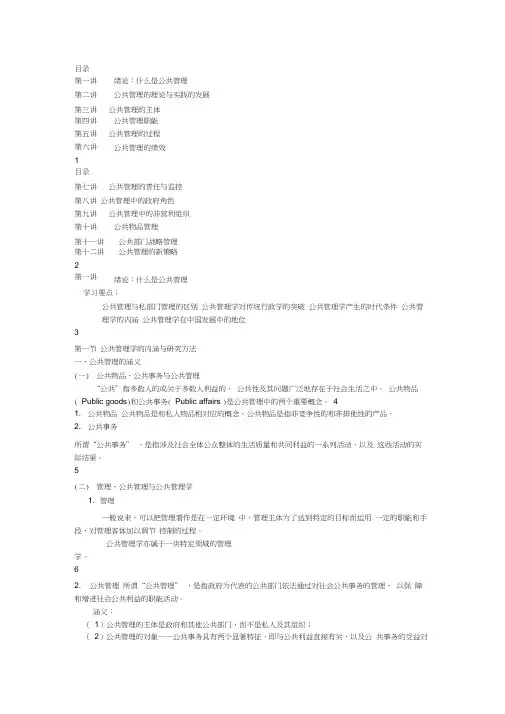
目录第一讲绪论:什么是公共管理第二讲公共管理的理论与实践的发展第三讲公共管理的主体第四讲公共管理职能第五讲公共管理的过程第六讲1目录公共管理的绩效第七讲公共管理的责任与监控第八讲公共管理中的政府角色第九讲公共管理中的非营利组织第十讲公共物品管理第十一讲公共部门战略管理第十二讲2第一讲公共管理的新策略绪论:什么是公共管理学习要点:公共管理与私部门管理的区别公共管理学对传统行政学的突破公共管理学产生的时代条件公共管理学的内涵公共管理学在中国发展中的地位3第一节公共管理学的内涵与研究方法一、公共管理的涵义(一)公共物品、公共事务与公共管理“公共”指多数人的或关于多数人利益的,公共性及其问题广泛地存在于社会生活之中。
公共物品( Public goods)和公共事务( Public affairs )是公共管理中的两个重要概念。
41. 公共物品公共物品是和私人物品相对应的概念。
公共物品是指非竞争性的和非排他性的产品。
2. 公共事务所谓“公共事务” ,是指涉及社会全体公众整体的生活质量和共同利益的一系列活动,以及这些活动的实际结果。
5(二)管理、公共管理与公共管理学1. 管理一般说来,可以把管理看作是在一定环境中,管理主体为了达到特定的目标而运用一定的职能和手段,对管理客体加以调节控制的过程。
公共管理学亦属于一类特定领域的管理学。
62. 公共管理所谓“公共管理” ,是指政府为代表的公共部门依法通过对社会公共事务的管理,以保障和增进社会公共利益的职能活动。
涵义:(1)公共管理的主体是政府和其他公共部门,而不是私人及其组织;(2)公共管理的对象——公共事务具有两个显著特征,即与公共利益直接有关,以及公共事务的受益对象是社会公众;7(3)由于公共事务关系到社会成员的利益,这就决定了公共事务及其管理的存在是永恒的,但具体内容会随着社会变迁不断调整;(4)公共管理来自民众的授权并负有直接的社会责任,因此,必须依法进行,其工作绩效也不能简单地以利润或效率作标准;(5)公共管理的公共性,决定了社会公众对公共管理部门拥有更多的制约权。
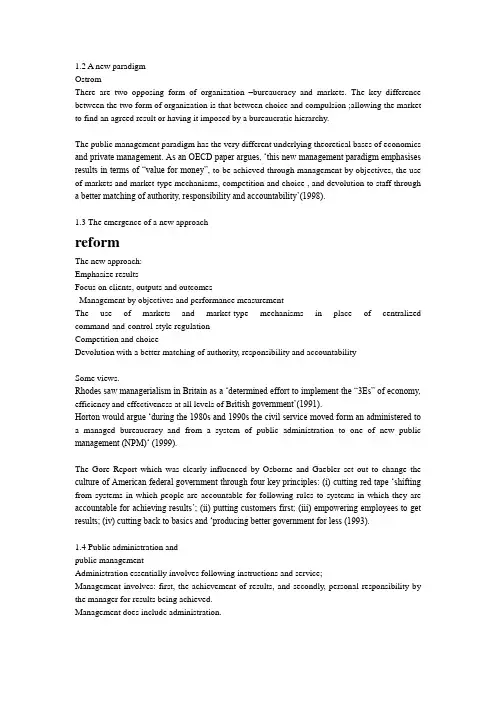
1.2 A new paradigmOstromThere are two opposing form of organization –bureaucracy and markets. The key difference between the two form of organization is that between choice and compulsion ;allowing the market to find an agreed result or having it imposed by a bureaucratic hierarchy.The public management paradigm has the very different underlying theoretical bases of economics and private management. As an OECD paper argues, ‗this new management paradigm emphasises results in terms of ―value for money‖, to be achieved through management by objectives, the use of markets and market-type mechanisms, competition and choice , and devolution to staff through a better matching of authority, responsibility and accountability‘(1998).1.3 The emergence of a new approachreformThe new approach:Emphasize resultsFocus on clients, outputs and outcomesManagement by objectives and performance measurementThe use of markets and market-type mechanisms in place of centralized command-and-control-style regulationCompetition and choiceDevolution with a better matching of authority, responsibility and accountabilitySome views.Rhodes saw managerialism in Britain as a ‗determined effort to implement the ―3Es‖ of economy, efficiency and effectiveness at all levels of Br itish government‘(1991).Horton would argue ‗during the 1980s and 1990s the civil service moved form an administered to a managed bureaucracy and from a system of public administration to one of new public management (NPM)‗ (1999).The Gore Report which was clearly influenced by Osborne and Gaebler set out to change the culture of American federal government through four key principles: (i) cutting red tape ‗shifting from systems in which people are accountable for following rules to systems in which they are accountable for achieving results‘; (ii) putting customers first; (iii) empowering employees to get results; (iv) cutting back to basics and ‗producing better government for less (1993).1.4 Public administration andpublic managementAdministration essentially involves following instructions and service;Management involves: first, the achievement of results, and secondly, personal responsibility by the manager for results being achieved.Management does include administration.Public administration andpublic managementPublic administrationBeside being an activity and a profession, it referred to the study of the public sector.Public administration is the use of managerial, political, and legal theories and processes to fulfil legislative, executive and judicial governmental mandates for the provision of regulatory and service functions for the society as a whole or for some segments of it.Public managementPublic management as a branch of the larger field of public administration or public affairs. Overviews the art and science of applied methodologies for public administrative program design and organisational restructuring, policy and management planning, resource allocations through budgeting systems, financial management, human resources management, and programme evaluation and audit.They was regarded as competing paradigms.1.5 Imperatives of changeThe changes in the public sector have occurred as a response to several interrelated imperatives:(1) The attack on the public sector;(2) Changes in economic theory;(3) The impact of change in the private sector ,particularly globalization as an economic force;(4)Changes in technology.(1)The attack on the public sector(i) The scale of the public sector was simply too large: consuming too many scarce resources. (ii) There were governmental responses to argument about the scope of government.(iii) There was a sustained attack on the methods of government, with bureaucracy in particular becoming highly unpopular.(2)Economic theory(i) Public choice theory.Public choice is a sub-branch of economic thought concerned with the application of microeconomics to political and areas (Mueller,1989). Public choice theorists generally conclude that the ‗best‘ outcome will involve a maximum role for market forces and a minimal role for government. Even if this view is often ideological, and not an axiom of the theory itself, they argue there is a substantial body of evidence that private markets are better than government or political markets. If the role of government in supplying goods and services could be reduced, the economy as a whole would benefit. Markets are also argued to have better mechanisms for accountability as opposed to a bureaucracy accountable to no one.(ii) Principal/agent theory.The economic theory of principal and agent has also been applied to the public sector, especially concerning its accountability. The theory was developed for the private sector to explain the divergence often found between the goals of managers (agents) in private firms and shareholders (principals).(iii) Transaction cost theory.As set out by Williamson (1986), this challenges the notion that transaction are without cost and specifies the circumstances where a firm many prefer market-testing or contracting to in-house provision. The same applies to the public sector; there are some transactions which would be less costly if contracted out to reduce administrative cost and provide some competition.(3)Private sector changeA further imperative for public sector change has been the rapid change in the private sector and the realization that the management and efficiency of the public sector affects the private economy and national competitiveness. A concern with national competitiveness leads fairly naturally to a need for reform of the public sector.(4)Technological changeTechnological change affects management, including the management of government. This should be regarded as one of the main driving forces both towards new forms of public management and away from traditional bureaucracy.Chapter 2.The Traditional Model of Public Administration2.1 Early administrationAdministrative systems existed in ancient Egypt to administer irrigation from the annual flood of Nile and to build the pyramids.China in the Han dynasty adopted the Confucian precept that government should be handled by men chosen, not by birth, but by virtue and ability.In Europe the various Empires controlled form the centre by rules and procedures. Characteristic :(1) ‗personal‘, based on loyalty to a particular individual such as a king or a minister.(2) ‗impersonal‘ ,based on legality and loyalty to the organization and the state.2.2 The reforms of the nineteenth century(1) ‗The Northcote -Trevelyan Report ‘, 1854.Appointment by merit through examinations, and non-partisan, neutral administration.It signals the start of merit- based appointments to the public service and the gradual decline of patronage.2.3 Weber‘s theory of bureaucracyWeber argued there were three types of authority:The charismatic – the appeal of an extraordinary leaderThe traditional - such as the authority of a tribal chief;Rational/legal authority.(1)Six principles for modern systems of bureaucracy set out by Weber.(i) Authority derives from the law , and from rules made according to law.(ii) The hierarchy.(iii) The organization is something with an existence separate from the private lives of its employees; it is impersonal.(iv) Administration is a specialist occupation .(v) Working for the bureaucracy was a fulltime occupation .(vi) Office management was an activity that could be learned as it followed general rules.(2)The position of the officialThe official is to be part of an elite with status higher than that of ordinary citizens.Web er‘s theory required recruitment by merit, not by election or by patronage, into a position normally held for life in exchange for impartial service. Part of the lifetime and full-time career of the public servant is the principle of fixed salary and the prospect of advancement through the hierarchical structure.The two principles – the model of bureaucracy and position of the official - had specific purposes.A formal, impersonal system offers ‗ the optimum possibility for carrying through the principle o f specialising functions according to purely objective considerations‘.The hierarchy of authority and the system of rules make for certainty in decision; and the impersonality of the system implies that the same decision can be repeated in the same circumstances; decisions are not made arbitrarily.2.4 Wilson and political controlWilson believed that the evils of the spoils system resulted from the linking of administrative question with political ones.The politics/ administration dichotomy.The worlds of the politician and the public official were to be separate.Political officesMake the rule.Be filled competitively in the political arena.Be selected on the basis of their political competence.Be judged by the electorate or their political peers.Be of limited tenure and subject to frequent elections.Bureaucratic officesDo their bidding.Be filled competitively in the bureaucratic arena.Be selected on the basis of their bureaucratic competence.Be judged by their political overseers or their bureaucratic peers.Be of unlimited tenure, subject to good behaviour.2.5 Taylor and managementScientific management-Frederick Taylor(i) Time-and-motion studies to decide a standard for working;(ii) A wage-incentive system that was a modification of the piecework method already in existence;(iii) Changing the functional organization.(2) Human relationThe theory‘s founder was Elton Mayo.(i) The social context of the work group was the most important factor in management.(ii) Conflict was pathological and to be avoided, and there was no necessary antagonism between management and workers.(iii) Productivity increased most by taking an interest in the workers.(3) A continuing debateSome people regard the theories of Taylor and Mayo as mutually exclusive-at one time theory is pre-eminent while at other times the other is-but this would be misleading.The same pointThey both did not favour unions orindustrial democracy.The goal of both-increased productivity-was the same.Both continue to influence managementin the public sector.(4)The Golden Age of public administrationThe Golden Age of public administration was from around 1920 to the early 1970s.One variation was the ‗POSDCORB‘ set of functions set out by Gulick and Urwick (1937).POSDCORBPlanning: goal setting techniques/methods applied by executives as a means of preparing future courses of organizational action;Organizing: arranging the organizational structure and processes in an appropriate manner essential to achieving these ends;Staffing: recruiting and hiring personal to carry out the essential agency work;Directing: supervising the actual processes of doing the assignments;Coordinating: integrating the various detailed elements of the work within the organization; Reporting: tracking and communicating the progress of the work within the organization; Budgeting: fiscal and financial activities necessary to economically support the completion of these programmes, services, or activities.2.6 Problems with the traditional modelThe problem of political controlThe problem of one best wayThe problem of bureaucracyThe public choice critique(1) The problem of political controlA strict separation between politicians and administrators, between policy and administration ,was never realistic in its original home.Peters(1989)Administration and policy, instead of being discrete phenomena, are actually interrelated. In both an objective and subjective manner, the nature of the administrative system can influence the policy outputs of the political system. Administration does make policy, although these policies are not always written and promulgated in the same manner as the rules made by legislatures and executives. Moreover, the operational rules developed by administrators can be more telling for the actual outcomes for individuals than are the formally promulgated rules.(2) The problem of one best wayTedious , trivial, copious, inflexible.Gulick‘s POSDCORBTaylor‘s scientificManagement(3) The problem of bureaucracyThe problems with the theory of bureaucracy.The problematic relationship between bureaucracy and democracy;Formal bureaucracy could not longer be considered as a particularly efficient form of organization.The problematic relationship between bureaucracy and democracyWith its formal rationality, secrecy, rigidity and hierarchy, it seems inevitable that there would be some conflict between bureaucracy and democracy.It did not make sense for a democracy to have a distinct elite acting secretively.There was and is some conflict between bureaucracy and democracy.Formal bureaucracy could not longer be considered as a particularly efficient form of organization There were always some extreme interpretations of Weberian principles, particularly in the personnel system, which was made more rigid, more formal and less elitist than Weber imagined, and this tended to reduce its efficiency.New theories of organizational behaviour argue that formal bureaucratic models are no longer particularly efficient or effective in any sense, when compared to more flexible forms of management .(4)The public choice critiqueThe confrontation of bureaucracy theory andpublic choice theory.The bureaucracyThe theory of publicChoice.Two main claims:Government bureaucracy greatly restricted the freedom of the individual and its power needed to be reduces in the name of ‗choice.Market economists argued that the traditional bureaucracy model did not provide an equivalent structure of incentives and rewards to those of the market. It was less efficient than market processes.Chapter 3. Public Management3.1 IntroductionThe 1980s and 1990s saw the emergence of a new managerial approach in the public sector, in response to what many regarded as the inadequacies of the traditional model of administration.Public management(1) It paid more attention to the achievement of results and the personal responsibility of managers.(2) There is an expressed intention to move away from classic bureaucracy .(3) Organizational and personal objectives are to be set clearly.(4) Senior staff are more likely to be politically committed to the government of the day.(5) Government functions are more likely to face market tests; in separating the purchaser of government services from the provider.(6) There is also a trend towards reducing government functions.3.2 The meaning of managementAdministration means following instructions .Management means the achievement of results and taking personal responsibility for doing so. 3.3 Functions of general management‗Functions of general management ‘—Allison(1982)STRA TEGY(1) Establishing objectives and priorities for the organization.(2) Devising operational plans to achieve these objectives.MANAGING INTERNAL COMPONENTS(3) Organizing and staffing.(4) Directing personnel and the personnel management system.(5) Controlling performance.MANAGING EXTERNAL CONSTITUENCIES(6) Dealing with ‗external units‘ of the organization.(7) Dealing with independent organization.(8) Dealing with the press and public.(1)Public management is management of the external environment of the organization;Public administration is within the context of the organization.(2) Traditional public administration tended to consider short-term goals within the organization. Public management aim at the longer term and at the relationship between the organization and the external environment.(3) Traditional public administration‘s some functions was not carried out to its fulles t.(4) Under the traditional model, the concepts of public service anonymity and neutrality. New public management focus on external environment, and public service anonymity has declined.3.4 The beginnings of management approachBetween 1950s to 1980s, one starting point is the 1968 Fulton Report in the United Kingdom. This report noted concerns with the management capability of the public service.Four aspects made up the total management task of the Civil Service:(1) Formulation of policy under political direction.(2) Creating the ‗machinery‘ for implementation of policy(3) Operation of the administrative machine.(4) Accountability to Parliament and the Public.3.5 The public management reformsInstead of there being reforms to the public sector, new public management represents a transformation of the public sector and its relationship with government and society.3.6 The managerial programmeThere are various ideas of what is involved in the public management of reforms.(1)Most countries are fol lowing ‗two broad avenues‘ to improve production and delivery of publicly provided goods and services(OECD,1991).① Raise the production performance of public organization.②Make greater use of the private sector.(2) ‗New public management‘ is comprised of seven main points:① Hands-on professional management in the public sector.② Explicit standards and measures of performance .③ Greater emphasis on output controls.④ A shift to disaggregation of units in the public sector.⑤ A shift to greater competition in the public sector.⑥ A stress on private sector styles of management practice.⑦ A stress on greater discipline and parsimony in resource use.--Hood 1991.(3)Holmes and Shand ,1995‗Good managerial approach‘:① A more strategic or results-oriented approach to decision-making.②The replacement of highly centralized hierarchical hierarchical organizational structures with decentralized management environment.③Flexibility to explore alternatives to direct public provision which might provide more cost-effective policy outcomes.④ Focusing attention on the matching of authority and responsibility.⑤ The creation of competitive environments within and between public sector organizations.⑥ The strengthening of strategic capacities at the centre to ‗steer‘ government.⑦ Greater accountability and transparency through requirement.⑧ Service-wide budgeting and management systems to support and encourage these changes.(4) Pollitt argued there were a number of general elements of the new model accepted by most commentators(2001).① A shift in the focus of management systems and management systems and management effort from inputs and processes to outputs and outcomes.② A shift towards more measurement.③ A performance for more specialized, ‗lean‘, ‗flat‘ and autonomous organization forms.④ A widespread substitution of contract or contract-like relationships for hierarchical relationships.⑤ A much wider than hitherto use of market or market-like mechanisms for the delivery of public services.⑥ A broad ening and blurring of the ‗frontier‘ between the public and private sectors.⑦ A shift in value priorities away from universalism, equity, security and resilience and towards efficiency and individualism.The main points involved in the public management reforms including those emerging from the various formulations.A strategic approach. Government have aimed to develop better methods for long-term planning and strategic management.Management not administration. Public management now requires professional management where administration did not.A focus on results. The organization must focus on outcomes or outputs, instead of inputs.Managerial reforms have stressed performance by individuals and by agencies.Improved financial management. The most important change in this area has been performance and programme budgeting systems to replace the older line-item budget and accounting systems. Flexibility in staffing. There has been a consistent trend away from position classification towards flexibility in arrangements for filing senior positions.Flexibility in organization. One aspect of organizational flexibility is disaggregation, which means splitting large departments into different parts by setting up agencies to deliver services for a small policy department.A shift to greater competition. Competition for provision through contracting, is seen as reducing costs compared to bureaucratic provision.The new contractualism. Under what has been called ‗contractualism‘ , any conceivable government service can be provided by contract.A stress on private sector styles of management practice. This includes staffing changes designed to better fit staff for their positions, to appraise their performance and to reward them accordingly with merit pay.Relationships with politicians. In the traditional, model the relationship with the political leadership was narrow and technical, of master and servant, of those giving the orders and those carrying them out. Under the public management model the relationship between politician and manager is more fluid and is closer than before.Relationships with the public. There is recognition of the need for direct accountability between managers and the public, as the result of demands for a ‗client focus‘ and for greater responsiveness to outside groups and individuals.Separation of purchaser and provider. Even if government is involved in an activity it does not need to be the final provider.Re-examining what government does. One important part of the public management reform process has been to examine and reexamine government programmes to ascertain if they are meeting their goals. (Six tests, public interest test, role of government test, federalism test, partnership test, efficiency test, affordability test.)Traditional public administration was based on two theories, the theory of bureaucracy and the theory of separation between politicians and administrators. There are also two main theoretical bases to new public management. These are economics and private management.There are two key assumptions in economics.First, there is the assumption of individual rationality, that individuals can be assumed to prefer more of something rather than less.Secondly, the individual rationality assumption allows the elaboration of models that can extend to high levels of abstraction. The second theoretical basis for public management can be found in private management. There are several managerial changes with antecedents in the private sector.3.8 Criticisms of managerialism(1) The economic basis of managerialismThere are two main criticisms of the economic basis of managerialism.① Economics is a flawed social science and its application to government is similarly flawed.②Economics has some validity as the basis for the economic system and private sector, its application to government is ill-conceived.(2) The basis in private management.The derivation of managerialism from a private business model is a source of criticism. The public sector might be so different that generic or private sector models of management become irrelevant to its operations.(3) ‗Neo- Taylorism‘.With its emphasis on the control of government spending and decentralizing management responsibilities with targets and performance measurement systems, Pollitt sees a management philosophy in the new model that he describes as ‗neo- Taylorian‘ (1993).(4) Politicization.There are two sides to the question of politicization.① It could be said that those making arguments about ‗politicization‘ ignore th e fact that the public service is fundamentally a political instrument.②Politicization could lead to problems of the kind that Woodrow Wilson and the reform movement in the 1880s tried to repair. Wilson argued that separation between politics and administration would reform the spoils system and reduce the corruption that system engendered.(5) Reduced accountabilityConflicts may occur between the concepts of public management and public accountability.(6) Difficulties with contracting-out.While it is easy to argue private markets are superior and efficiencies will result from privatizing government activities, implementation is not simple.(7) Ethical issues(8) Implementation and morale problemsChapter.5The Role of Government5.1 IntroductionWhat government should or should not doneeds to be of fundamental concern to publicManagers.The debate is now whether governmentsshould have no role, but what that role shouldBe.Public sector and private sector.IntroductionIn mixed economies there must be somedemarcation between those activities that fall ineither the public sector or the private sector.Since the mid-1970s, most OECD nations haveundertaken a reassessment of the role of theirpublic sectors.IntroductionThe current debate on the role of governmentmainly concern its economic aspects: should itprovide the goods and services it does, orshould some be handed to the private sectors?Should it subsidize or regulate to the extent itdoes? Such questions also raise the very politicalmatter of how various members of the communityperceive and value the things government does.5.2 The need for a public sectorBy convention, the economy is divided between the private and public sector.Governments are command-based.Markets are voluntary.Setting up a strict dichotomy between the private and public sectors is rather misleading.The private sector relies on government for infrastructure and the system of laws, without which markets could not operate.Government relies on the private sector for the production and supply of goods and services, and for tax revenue.Private and public managementThere are several reasons why the two sectors are not the same, and cannot be the same.(1) In a way not characteristic of the private sector, public sector decisions may be coercive.(2) The public sector has different forms ofaccountability from the private sector.(3) The public service manager must cope with an outside agenda largely set by the political leadership.(4) The public sector has inherent difficulties in measuring output or efficiency in production.(5) The public sector‘s sheer size and diversity make any control of coordination difficult.‗Government‘ and ‗governance‘Government is the institution itself, is the subset that acts with authority and creates formal obligations.Governance is a broader concept describing forms of governing which are not necessarily in the hands of the formal government. It mean the processes and institution, both formal and informal. It also argue that, with globalization, government is becoming more diffuse and that instead of governments having a monopoly over issues of governance there are many players.5.3 Market failure as the basis for public policyThe market mech anism alone cannot perform all economic functions; public policy is needed ‗to guide, correct, and supplement it in certain respects‘.The key kinds of market failure .Public goods.Externalities.Market transactions often have effects on third parties, or on the environment, that only government action can alleviate.Natural monopolyGovernment involvement need not mean direct government provision, and there is now a worldwide trend to privatization of such services but with some form of government regulation attached.The key kinds of market failure .Imperfect information.Market theory does assume perfect information for buyers and sellers. To the extent that information is not gained, especially by the buyer, markets can be less than optimal.Limitation of market failureSome people think market failure may result in too much government. Other people agree it may artificially reduce the scope of government action.5.4 Instruments of governmentGovernment provision Subsidy Production RegulationGovernment provisionDirect provision by government through the budget forms the major part of its operations.SubsidySubsidies vary widely but could include subsidies to farmers or industry, or to private bus companies or private schools.ProductionUnlike provision, production takes place away from the government budget, and users are charged in the same way as if the items were provided by the private sector.。
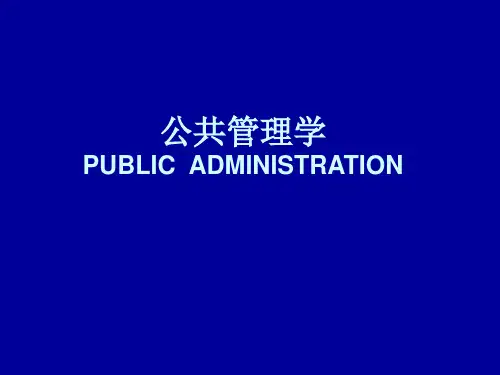
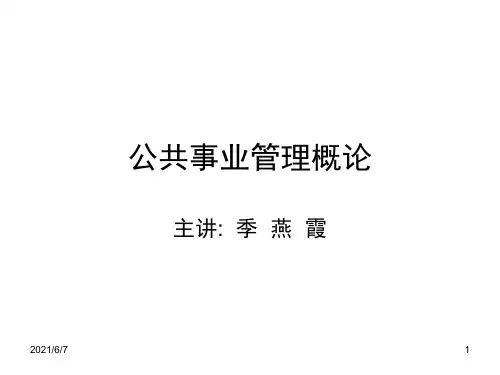

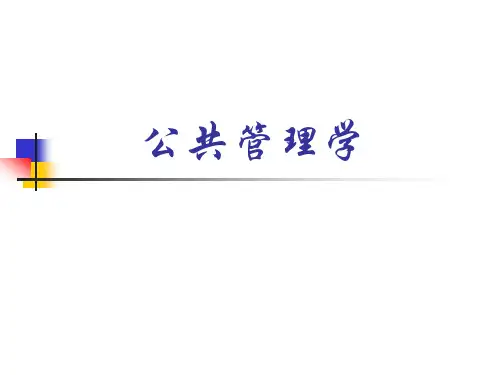
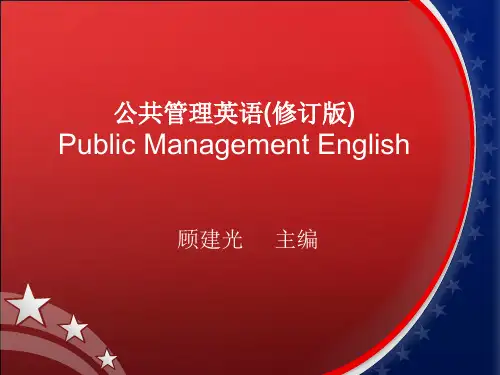
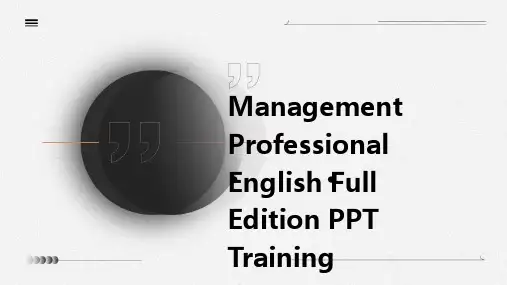
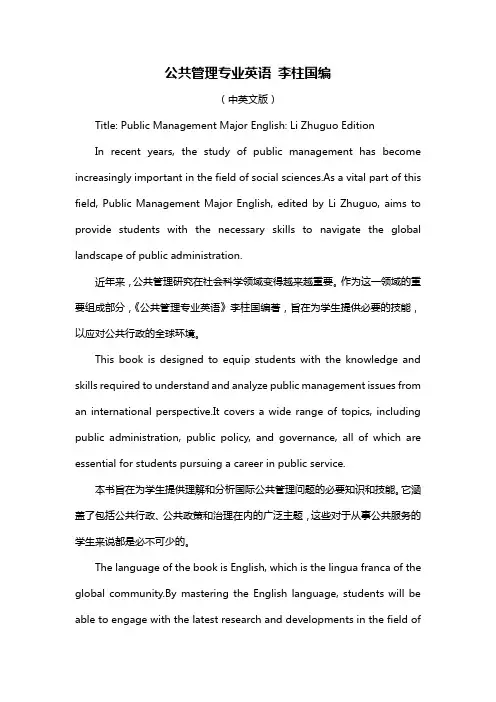
公共管理专业英语李柱国编(中英文版)Title: Public Management Major English: Li Zhuguo EditionIn recent years, the study of public management has become increasingly important in the field of social sciences.As a vital part of this field, Public Management Major English, edited by Li Zhuguo, aims to provide students with the necessary skills to navigate the global landscape of public administration.近年来,公共管理研究在社会科学领域变得越来越重要。
作为这一领域的重要组成部分,《公共管理专业英语》李柱国编著,旨在为学生提供必要的技能,以应对公共行政的全球环境。
This book is designed to equip students with the knowledge and skills required to understand and analyze public management issues from an international perspective.It covers a wide range of topics, including public administration, public policy, and governance, all of which are essential for students pursuing a career in public service.本书旨在为学生提供理解和分析国际公共管理问题的必要知识和技能。
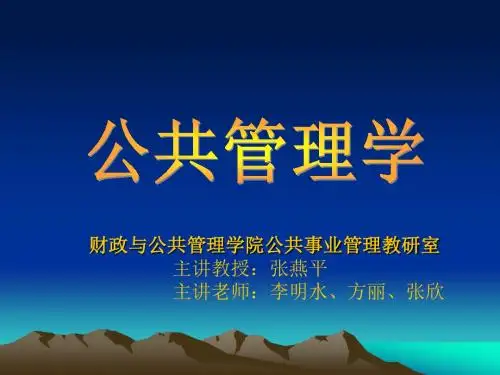
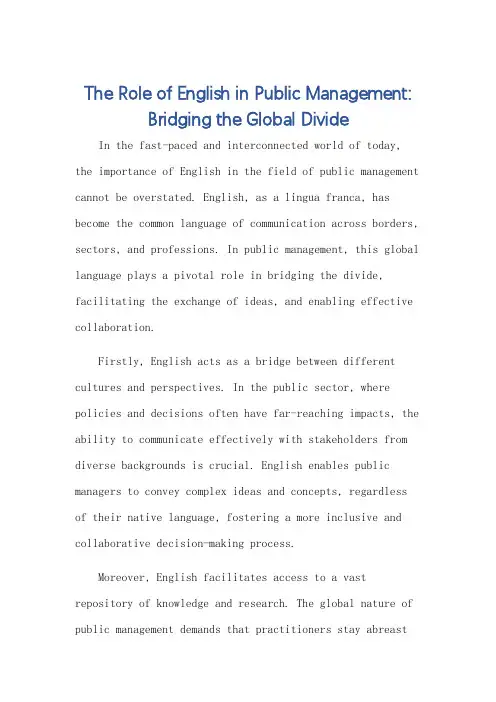
The Role of English in Public Management: Bridging the Global DivideIn the fast-paced and interconnected world of today, the importance of English in the field of public management cannot be overstated. English, as a lingua franca, has become the common language of communication across borders, sectors, and professions. In public management, this global language plays a pivotal role in bridging the divide, facilitating the exchange of ideas, and enabling effective collaboration.Firstly, English acts as a bridge between different cultures and perspectives. In the public sector, where policies and decisions often have far-reaching impacts, the ability to communicate effectively with stakeholders from diverse backgrounds is crucial. English enables public managers to convey complex ideas and concepts, regardless of their native language, fostering a more inclusive and collaborative decision-making process.Moreover, English facilitates access to a vast repository of knowledge and research. The global nature of public management demands that practitioners stay abreastof trends, best practices, and innovations from around the world. By reading and writing in English, public managers can tap into this rich resource, enhancing their professional capabilities and informing their policies and strategies.Additionally, English is essential for public managers seeking to engage with international organizations and partners. In an era of globalization, cross-border cooperation and partnerships are becoming increasingly common. By communicating in English, public managers can build relationships, share experiences, and collaborate effectively with their peers from other countries, contributing to the global public good.Furthermore, English acts as a tool for professional development. Public management is a dynamic field that requires continuous learning and adaptation. English-language courses and training programs provide public managers with the opportunity to enhance their skills, expand their networks, and prepare themselves for leadership roles in the global arena.In conclusion, English is indispensable in public management. It acts as a bridge between cultures, facilitates access to knowledge, enables international collaboration, and drives professional development. As the world becomes increasingly interconnected, the role of English in public management will continue to grow, making it even more crucial for practitioners to master this global language.**公共管理专业英语的重要性:跨越全球鸿沟**在当今快节奏、高度互联的世界中,英语在公共管理专业中的重要性不言而喻。
第一章1、There has been a transformation in the management of the public sectors of advanced countries. 发达国家公共部门的管理经历了一场转变。
2、This new paradigm poses a direct challenge to several of what had previously been regarded as fundamental principles of traditional public administration.这种新的典范对曾被认为是公共行政的一些基本的、几乎是永恒的原理提出了直接的挑战。
3、All these points will be discussed at greater length later,but the main point is there has been total change in a profession that saw little change for around a hundred years.虽然上述一切都值得深入探讨,这里强调的主要一点是,在100年来很少发生变化的公共部门职业领域,如今已经发生了全面的变革。
4、There is some debate over whether or not public management,particularly the new public management,is a new paradigm for public sector management.这里有一些争论,关于是否公共管理,特别是新公共管理是公共部门管理的新典范。
5、Some argue that paradigm is large hurdle to jump,requiring agreement among all a discipline's practitioners -- a more or less permanent way of looking at the world.一些人认为典范是巨大的障碍,需要协议在所有学科的实践者——或多或少永久看待世界的方式。